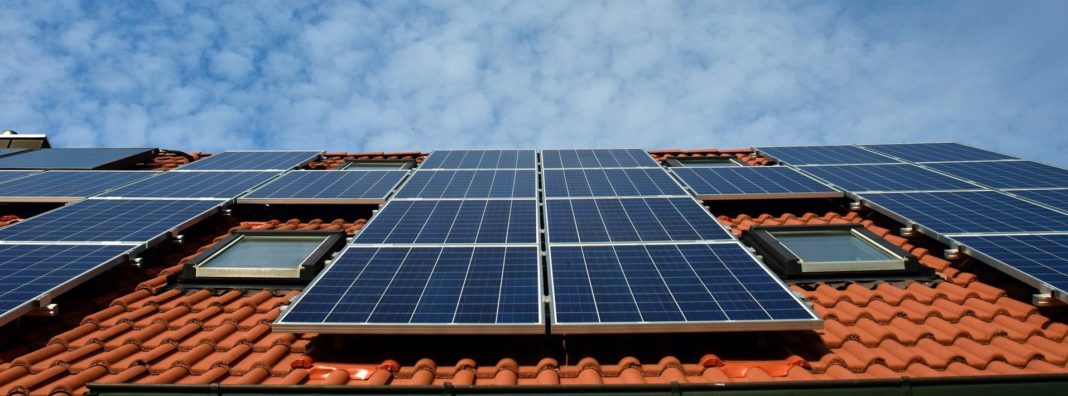
How much is rooftop solar worth? This simple question has stimulated a raging debate between electric utilities and solar advocates, both in Utah and around the country.
The issue comes down to how utilities should account for electricity that rooftop solar owners feed onto the electrical grid. Utah’s largest utility, Rocky Mountain Power (RMP), wants to pay just 1.5 cents per kilowatt-hour (kWh) to rooftop solar owners. RMP argues that it is around the price they would pay for solar electricity from larger, utility-scale, providers. They also point out that rooftop solar production creates costs for the utility that owners should be responsible for. Rooftop solar advocates, on the other hand, argue that the environmental benefits and other advantages of rooftop solar amount to a value of 24 cents per kWh.
This difference in perspective puts solar advocates and utilities about 22 cents apart on the value of rooftop solar. That 22-cent difference alone is double Utah’s average electricity rate of 11 cents per kWh. To understand what is driving this large discrepancy between two well-informed groups requires a clear understanding of what goes into pricing electricity.
What’s in a price?
The price that you see on your utility bill each month is made up of several components. There’s the cost of generating the electricity in the first place, the cost of transmission to you, and maintenance costs for keeping the electrical grid available for all users to draw on at any moment.
The federal Energy Information Administration (EIA) shows that Utah’s households pay, on average, about 11 cents per kWh. The US average is a bit higher at around 13 cents per kWh. Only a small portion of these prices are tied to generation costs. On the wholesale market, where utilities purchase electricity based largely on the cost of generation, prices roughly vary between 2 cents and 5 cents on average. What’s important, however, is the “on average” point. In reality, there’s a lot of variation.
Electricity generation prices jump up and down dramatically by time of day and can even vary significantly from minute to minute. Heatwaves can generate substantial price swings as everyone turns on their air conditioners, and demand for electricity shoots up. When prices are peaking on hot days, the wholesale price of electricity can skyrocket. As the chart below shows, California hit a price of $600/MWh, which is 60¢/kWh, on a hot August day surrounding the state’s recent blackouts.
Source: Bloomberg.
In contrast, sometimes, too much electricity is generated, which drives prices below zero — meaning generators have to pay users to take their electricity. With these possibilities in mind, a flat compensation rate for rooftop solar cannot adequately account for the changing value of the energy it produces.
This is a fundamental flaw in the current compensation system for rooftop solar. The value of solar isn’t either 1.5 cents per kWh or 24 cents per kWh. It’s not any single price all the time. Rooftop solar could be worth a lot in certain places and at certain times. In the same vein, there are times when electricity generation isn’t needed and the value of rooftop solar is close to nothing.
RMP’s proposal attempts to get at this idea with a rough cut between on-peak and off-peak hours. They suggest paying $0.013 off-peak and $0.026/kWh for on-peak production, which is an hourly average of $0.015/kWh. The peak is simply the time when the grid is being used the most. Peaking hours are generally the most expensive times for running the electrical grid, making it the most valuable time for energy generation.
Paying a higher on-peak price and a lower off-peak price is not a perfect solution — there will be times that the value of solar energy at peak moments is higher than 2.6 cents per kWh or at off-demand times is lower than 1.5 cent per kWh. It is a step towards a better valuation for solar, but it’s not going far enough. A better way to price rooftop solar’s value would be to tie it to real-time pricing. Electricity’s value isn’t constant, so regulators should reject rigid valuations for electricity generation.
A dynamic pricing system tied to the value of electricity that emerges from the market can even give rooftop solar owners an incentive to pay attention to the broader system’s needs. That is, on a hot day, when prices are peaking, as in the example from California, rooftop solar owners could cut back on their consumption to take advantage of the rising prices. They can then feed the extra energy onto the electrical grid to make more money from their solar panels. Without designing regulations to create this incentive, we’re missing out on rooftop solar’s potential to keep the lights on.
The future of electricity is moving in towards easier and expanded control for consumers, as is clear from the success of smart thermostats like Nest and EcoBee. A real-time system will better take advantage of those technological advancements. And it does so by reducing the risk of overestimating the value of solar compared to a less realistic on-peak and off-peak system or the current system’s total consumed to total produced.
What about solar’s environmental benefits?
One benefit of rooftop solar that is not considered in the cost of generation, but that advocates argue justifies higher rates, is the production of clean energy. Rooftop solar cleans up the environment when it replaces carbon-based energy sources like coal or natural gas. That’s a benefit to us all. Still, as utilities begin to build more and more utility-scale green energy projects, requiring them to pay more for rooftop solar energy than they would otherwise pay for utility-scale renewable energy is forcing them to make a sub-optimal investment.
Compare the cost of powering a home on rooftop solar electricity with powering a home with utility-scale solar. An average home requires about 10,972 kWh of energy to power it for a full year. At 24 cents per kWh, RMP would be paying $2,633.28 just to buy the energy needed to power a home for an entire year using rooftop solar. That’s compared to between $219.44 and $548.60 for utility-scale solar. In reality, homes are powered by a mix of electricity sources, so this overestimates the costs. Still, it’s a useful illustration of why a change to 24 cents per kWh will mean paying much more for electricity just because it’s from a rooftop installation, not a utility-scale source.
That higher cost not only impacts the price ratepayers pay for their electricity but competes with other renewable investments that could be made. There’s growing economic and environmental value in focusing on utility-scale solar and efficient energy production. The cheaper we can make renewable energy, the more likely it will be to continue to grow as a portion of overall US electricity generation.
The best way to account for the value of solar’s environmental benefit is through wider policy changes, like accounting for the social cost of carbon through a carbon tax, rather than supporting specific technologies. That allows more flexibility for producers and consumers to focus on technology that not only reduces our carbon footprint in the most efficient way possible.
The costs of overestimating solar’s value
Setting a high fixed price for solar will certainly make it likely more people will adopt rooftop solar, but there are downsides to that type of incentivized development. If the fixed price is set too high, it incentivizes rooftop solar installations everywhere, not just where they are valuable to the operation of the electrical grid. The resulting situation would be one where rooftop solar owners are paid a lot for the energy they produce despite that energy having little value or failing to be a useful substitute for fossil fuels. That increases the cost of producing solar energy at a time when lowering costs is the key to increasing renewable generation. Moving away from fixed pricing and towards variable pricing that changes with demand will provide a better mechanism for approximating the value of rooftop solar energy.
Additionally, when rooftop solar owners are compensated at overly-generous rates, they don’t cover their share of the costs for maintaining the electrical grid. Instead, those costs are shifted onto other consumers.
The cost-shift happens because the costs of maintaining the wires and lines that make up the electrical grid are spread out across every household. When rooftop solar customers don’t pay an electric bill because their energy generation exceeds their use, the costs of those wires and lines fall to other consumers. That’s a problem because rooftop solar owners still use the grid. If nothing else, the grid operates as a battery for rooftop solar owners, giving them the option to draw on it whenever they need — like at night when solar is not producing. This option value is a service everyone should pay for equally.
When there are few rooftop solar installations, the burden of shifting grid maintenance costs and other fixed costs onto non-solar households is not that significant. But those costs begin to matter as more and more people adopt solar. That is why it’s smart for utilities to start considering better ways to compensate rooftop solar owners. The cost of solar panels has fallen dramatically over the last 20 years and we should expect that trend to continue. As costs decline, more and more people will turn to rooftop solar as a viable investment for their homes. If policies aren’t set up to handle the deployment of more rooftop solar, then we’ll have missed an opportunity to open up the possibility of a greener future powered by new technologies.
What we should do
The ideal system for rooftop solar compensation would be a price tied to real-time rates. Like other generators, the chief value of rooftop solar for the electrical grid is in generation. We should treat rooftop solar like other generators and pay producers for the value they create. Real-time pricing would do just that by reflecting the needs on the electrical grid as they really are. And compensating solar owners based on generation ensures that rooftop solar owners are also paying their share of grid operation and maintenance rather than passing those costs onto non-solar households.
The right way to reward solar for its environmental benefits isn’t through arbitrarily paying rooftop solar substantially more than larger solar producers receive, but through a direct tax on carbon that reflects the negative impacts of emissions. Instead of over-incentivizing rooftop solar, taxing carbon ensures energy pricing more accurately accounts for environmental impacts. Clean technologies like rooftop solar can then compete against other low-carbon technologies and fossil fuel sources like coal and natural gas.
We need smart reform today in order to lay the groundwork for the next evolution of energy technologies. Rooftop solar is just the start. As new technologies like smart meters and thermostats become commonplace, they bring more opportunities to promote a cleaner future. A change to real-time pricing and compensation for rooftop solar owners would be a positive shift toward this future and a huge opportunity for new innovation in electricity markets.


